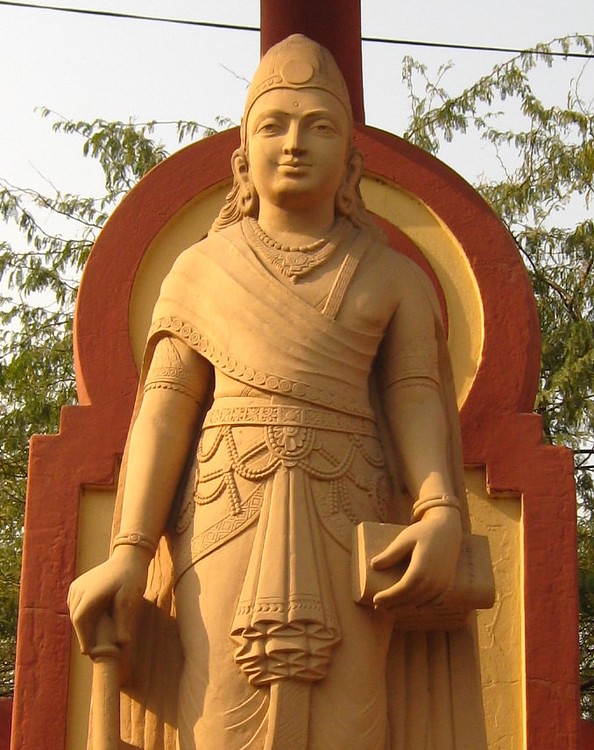Chandragupta Maurya
Before the time of Chandragupta, India was mostly composed of a number of small independent states, with the exception of the Magadha kingdom, a realm that controlled most of Northern India, which was ruled by the Nanda dynasty. Chandragupta began a process that would unify India for the first time in history.
THE LIBERATION OF INDIA
During 326 BCE, while fighting his way into India, Alexander the Great came across the army of King Porus, the ruler of the local state of Paurava, located in modern day Punjab. After fighting to his last breath, King Porus surrendered to Alexander, who was impressed by the courage and stature of his enemy. Alexander made Porus his ally and turned him into king of all conquered India as a Macedonian tributary. Shortly after this, Alexander’s army refused to go any further into Asia; his men mutinied and thus the Macedonian army turned back and left India.
 |
| Design of a peacock, on the stairway balustrade of the Great Stupa at Sanchi |
 |
| Design of a peacock, on the railing of the Bharhut Stupa |
 |
| Chandragupta's guru was Chanakya, with whom he studied as a child and with whose counsel he built the Empire. This image is a 1915 artistic portrait of Chanakya |
Arts and architecture
The evidence of arts and architecture during Chandragupta's time is limited, predominantly texts such as those by Megasthenes and Kautilya's Arthashastra. The edict inscriptions and carvings on monumental pillars are attributed to his grandson Ashoka. The texts imply cities, public works and prosperous architecture, but the historicity of these is in question.
 |
| Didarganj Yakshi, discovered in 1917 buried in the banks of the Ganges. Dating varies from the 3rd century BCE, to the 2nd century CE |
Archeological discoveries in the modern age, such as Didarganj Yakshi discovered in 1917 buried beneath the banks of the River Ganges suggest exceptional artisanal accomplishment. It has been dated to the 3rd century BCE by many scholars, but later dates such as 2nd century BCE or the Kushan era (1st-4th century CE) have also been proposed. The competing theories are that the arts linked to Chandragupta Maurya's dynasty was learnt from the Greeks and West Asia in the years Alexander the Great waged war, while the other credits more ancient indigenous Indian tradition. According to Frederick Asher, "we cannot pretend to have definitive answers; and perhaps, as with most art, we must recognize that there is no single answer or explanation".
THE GOVERNMENT OF CHANDRAGUPTA & IMPERIAL EXPANSION
During the government of Chandragupta, we find the Greek Magasthenes, an ambassador of Seleucus, who lived in the court of Pataliputra from 317-312 BCE. He wrote many different reports about India and although his original work is lost, we can piece together some information found in subsequent works. He reported that the Indians:
[...] never drink wine except at sacrifice [...] The simplicity of their laws and their contracts is proved by the fact that they seldom go to law. They have no suits about pledges and deposits, nor do they require either seals or witnesses, but make their deposits and confide in each other.
(Durant, 441)
 |
| Chndragupta Maurya's empire. |
Magasthenes also reports that Pataliputra was nine miles in length and about two miles in width. Chandragupta’s palace was full of luxuries and all type of ostentatious possessions. Inside his palace, Chandragupta paid the price of ascending to power through the use of violence: he lived in it for 24 years, almost as a recluse, with very limited public exposure, solely devoted to the growth of the empire. He managed to extend his empire westwards and became the master of all Northern India. According to the reports of Magasthenes, Chandragupta’s army was composed of 600,000 foot soldiers, 30,000 horses, and 9,000 war elephants.
After becoming the master of all Northern India, Chandragupta began a campaign to conquer the southern half of the Indian subcontinent. Battle after battle, the Mauryan forces absorbed most of the independent Indian states until eventually, in 300 BCE, the borders of the Mauryan Empire extended southward into the Deccan Plateau. Chandragupta, however, failed to annex the small kingdom of Kalinga in present day Odisha in central-eastern India, on the Bay of Bengal. This pending conquest would be completed in 260 BCE by Emperor Ashoka.
ABDICATION & DEATH
In 298 BCE, Chandragupta voluntarily abdicated the throne in favour of his son Bindusara, who became the new Mauryan emperor. What we know after this point seems closer to legend than an actual historical account. It is said that Chandragupta turned into an ascetic and follower of Jainism. Jain tradition claims that Chandragupta migrated south and, consistent with the beliefs of Jainism, he starved himself to death inside a cave. This event supposedly took place in Sravana Belgola, a city about 150 kilometers away from Bangalore, which is one of the most important places of pilgrimage in Jainism.

No comments:
Post a Comment